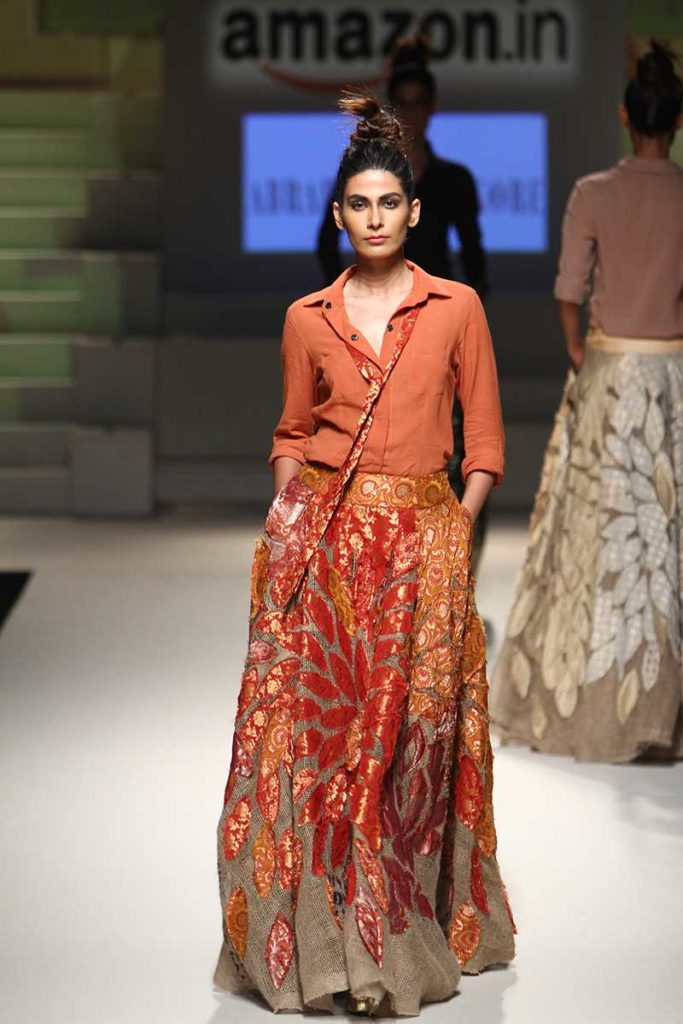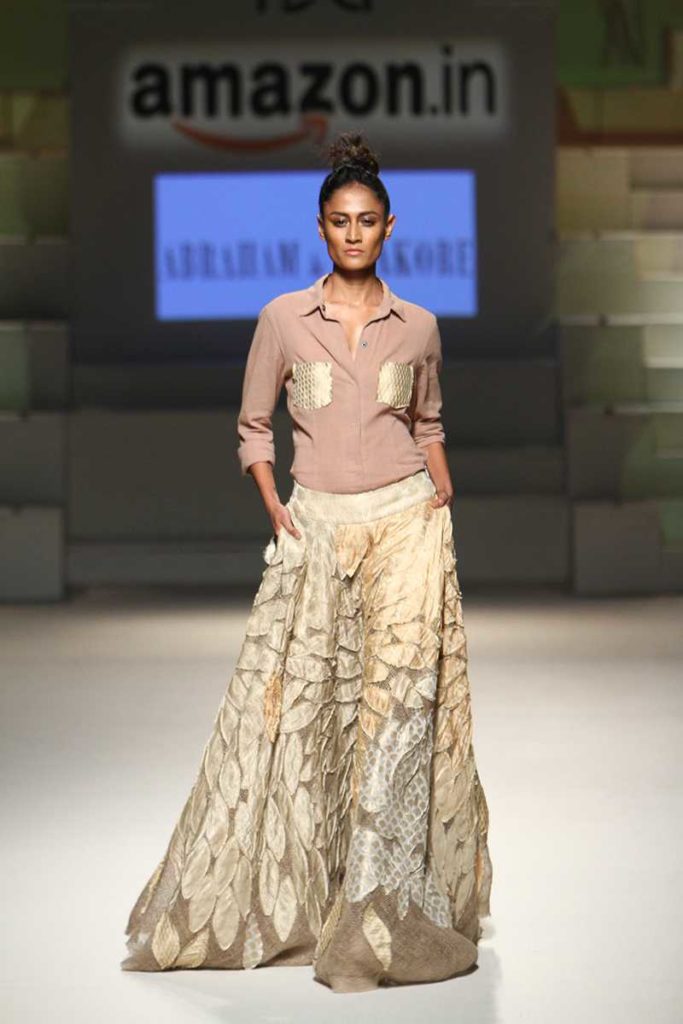Varanasi is said to be the oldest city in the world and is well known for the Benerasi fabric that is woven into beautiful sarees as well as more contemporary kinds of clothing. However the industry is reeling under an onslaught of power machines and a new generation that is not keen on pursuing the craft.
Weaves Matter
‘Benarasi’ is indeed the ‘Fabric of Antiquity.’ Benares brocades are unique in their complexity and richness. The structure of the weave allows for complex figured motifs to be woven in a large number of colours. Banarasi saris come in different weaves and also different types of silks, which means that you get a lot more variety to choose from each different from the other basis the type of motif or pattern weaved onto the textile. Sagrika Rai, Founder, Warp n Weft says, “the weaves with provenance are as sacred as the city, Varanasi, which imbues it with spirituality and history. Having become a cynosure of cultural and creative activity, Varanasi or Benaras along with its famed brocade and silk weaves have occupied a key position in the landscape of handloom in the Indian subcontinent.” Designer Lira Gupta, Filme Fashion adds, “the weave is one of its own kind. The handwork and patience put behind making one piece is always shown on the garment or on the fabrics. You get the sense of your roots and your history by wearing them and also a poise when you put it on.”
Unique Art
Banarasi weaves brings along with it stories of heritage and intricate craftsmanship. “A pure handloom Banarasi silk saree takes anywhere from 1 to 6 months to be woven depending upon the design and pattern. There is a lot of time and energy invested into creating such a saree which is no less than a master art piece. Authentic Banarasi weaves are made on handlooms under the guidance of the master weaver in various varieties like Tanchoi silk, Banarsi Jangla, Banarsi cutwork and few more. The intricate designs and patterns on the sarees are highly influenced by the Mughal era and one can often see florals, animals, birds and vines as motifs and on the borders of Banarasi Saris,” says Monica Gupta, Co-Founder, Craftsvilla. The process of Benarasi weaves is quite typical in nature that cannot be easily duplicated or imitable. The two most peculiar techniques of the weaves are “kadhua” and “kadhiyal”. “Kadhua is a technique where the weaver has to weave each boota individually as opposed to the ‘fekwa’ technique where the weaver weaves all the boota’s together in the same width with float yarns in the back side that have to be cut manually with scissors later on. This tactic has more impact as compared to fekwa technique. Kadhiyal is the most complicated weaving technique which no powerloom machine has ever been able to replicate. In this technique a weaver can weave two different natures of fabric in the same width. For example, we make a kadhiyal saree wherein the entire body of the saree is in kora – organza fabric and the border area in the same width is woven in Tussar fabric. In this technique, the weaver throws a different shuttle for kora yarn and a different shuttle for tussar yarn in the same weft simultaneously. Just where both the yarns meet, the weaver manually intertwines both the yarns and throws them back in the weft in their respective shuttles,” explains Utkarsh Rastogi, Founder, Kaasi Saree.
Challenges Galore
Today the handloom sector is overshadowed by the overpowering presence of the mill and power loom sector. Their aggressive, organized and well-funded lobbies have done a lot to ensure that the voice and needs of the handloom weaver are not given their due. “The impact in the sector has reached serious proportions. Weavers have begun to do other work, such as pulling rickshaws, making incense sticks, and the women have begun to do domestic labour in the homes of middle class families. In addition, weavers are leaving Banaras and migrating to Surat. This is due to the better status of weavers in that city, which has a better demand for their products and provides better wages for their work. In fact in Surat, many weavers are ironically joining the ‘duplicate’ banarasi sari manufacturing process, as it is becoming increasingly economically viable to do that,” say David Abraham and Rakesh Thakore of Abraham and Thakore. The introduction of the power loom reduced the demand for cloth produced by handloom weavers.. The average wage of a weaver fell drastically; weavers who work in factories can earn more than double the money. If you work on a handloom you get 200 rupees a day but it’s around 500 if you work with an electric loom. With a handloom you get one metre (of cloth) in a day and with machine-loom it is 10 metres. It’s all about quantity. Those who still found masters willing to employ them had to accept far lower wages than in the past and this led to the downfall of hand weaves and the market for Banarasi weaves declined drastically.
Revival Measures
The government is trying to create better awareness for handloom textiles, and in addition many fashion designers have begun to work with the handloom sector and are beginning to bring attention to these textiles. Today there are NGO’s and different organizations supporting the handloom sector and reviving the art of handloom weaving. The government responded to the weavers by establishing co-operative institutions. The objective was to develop forward (marketing of sarees) and backward (providing raw silk) linkages to ameliorate conditions of weavers. Micro-credit facility forms an important component. The current research shows situation of weavers are good and they got Government support in financial, marketing of Banarasi sarees. Establishment or revival of trade unions, cooperatives, and other workers’ organisations is must for sustainable development. “An online portal on weaving could go a long way in spreading awareness and promoting sales. It would enhance direct market access to weavers, nationally and internationally. Other mechanisms of direct market access can be ‘artisan haats’ in the line of ‘DilliHaat’ and exhibitions at local and national levels. Besides this, up-gradation/integration of weavers’ expositions into the traditional melas of Varanasi would be beneficial. A local museum to document the various practices in the saree-weaving sectors is required,” opines Fashion Designer Sumona Parekh. Anuradha P. Dhawan, Creative Director Anu PD House of A4A opines, “efforts are being made by NGOs and benefactors, like by the Banarasi Weaver Association, Bunkar (Weaver) Dastakar Adhikaar Manch, Varanasi. This provides the weavers a platform to sell their sarees online to the global diaspora cutting intermediaries which are exploiting the grassroots weaver for centuries. Weavers here have existed from the time of Buddha down the ages when the Mughal motifs revitalised the designs of brocades and now many modern designers referencing contemporary patterns and fashion designers fashioning this rich fabric in many versatile ways.”
Government Impetus
The Prime Minister has initiated the ‘Make in India’ campaign that has envisioned and enlightened every Indian around the globe to think twice before buying a non-Indian hand made products. “A veteran leader of BJP, Shaina N.C. had initiated a movement where she collected over 70 popular fashion designers of our country and got them to Beneras for a joint meet with the manufactures to discuss the scope of Benerasi weaves in the fashion sector and to find ways to revive the century old craft of Benerasi weaves. The success for the handloom industry was when the handpicked collection of Benarasi sarees and fabrics were showcased at the Lakme Fashion week by the ministry of textile in Mumbai. Another major step taken by Government was by celebrating National Handloom day in Beneras under the guidelines of textile minister Smriti Irani where in there was an active participation by a dozen budding textile designers from the National Institute of Fashion Technology, New Delhi. We at Kaasi make it a point to educate our buyers to an extent that they can easily tell the difference between an authentic handloom saree and an unauthentic one. Also, a small subsidiary of Nift has opened in Varanasi, at the “Weaver’s Service Centre” where in they invite young boys and girls to learn the process of hand – weaving at a very nominal fees structure,” says Rastogi.
This story appeared in the Feb-2017 issue of Apparel Magazine here: Banarasi
All images in this post courtesy: Abraham and Thakore


